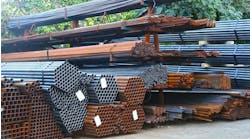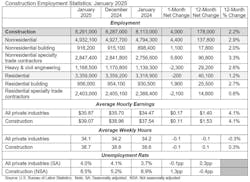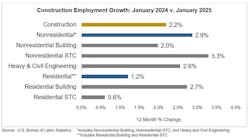Latest from Construction Data
Sponsored
WASHINGTON, DC — The construction industry added 4,000 jobs on net in January, according to an Associated Builders and Contractors analysis of data released by the US Bureau of Labor Statistics. On a year-over-year basis, industry employment has increased by 178,000 jobs, an increase of 2.2%.
Nonresidential construction employment increased by 4,400 positions on net, with growth in 2 of the 3 subcategories. Nonresidential specialty trade added the most jobs, increasing by 5,600 positions, followed by nonresidential building, which added 1,100 jobs. Heavy and civil engineering lost 2,300 jobs last month.
The construction unemployment rate rose to 6.5% in January. Unemployment across all industries decreased from 4.1% in December to 4.0% last month.
“Construction hiring has slowed to a crawl since October, with the industry averaging just 6,000 net new jobs per month,” said ABC Chief Economist Anirban Basu. “This is largely a reflection of weakness in the residential sector, which actually lost 200 jobs in January. Given the ongoing effects of high interest rates and the sharp decline in the number of housing units under construction, residential employment should continue to pull back over the next few quarters.
“Slowing demand for labor on the residential side of the industry could very well benefit nonresidential contractors,” said Basu. “Average hourly earnings for construction workers were up 4.1% on a year-over-year basis in January. While that’s still fast wage growth by historical standards, it’s also the smallest annual increase since 2021. With a majority of contractors expecting to expand their staffing levels over the first half of the year, according to ABC’s Construction Confidence Index, the availability of workers who would otherwise work on the residential side of the industry should help nonresidential wage growth return to healthier levels.”
Visit abc.org/economics for the Construction Backlog Indicator and Construction Confidence Index, plus analysis of spending, employment, job openings and the Producer Price Index.




